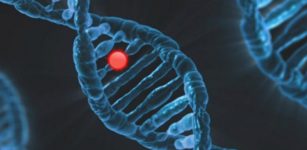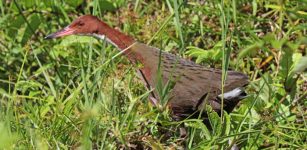Researchers Discover Unique Way Snakes Replace Their Teeth
Eddie Gonzales Jr. – MessageToEagle.com – A new study, led by a researcher from the Centre for Oral, Clinical & Translational Sciences at King’s College London, has identified key differences in tooth replacement between snakes and other reptiles, and identified the mechanism that allows snakes to shed their old teeth.
A skeleton of a Gaboon viper (Bitis gabonica). Attribution: Stefan3345, CC BY-SA 4.0, via Wikimedia Commons
Most reptiles replace their teeth with new ones constantly. However, snake teeth show no signs of how old teeth are removed from the jaw. In contrast, other reptiles have a ‘replacement pit’ that forms when a new tooth begins to grow. This replacement pit eats away at the base of the older tooth helping it to be shed in a process known as external tooth resorption.
The study’s findings revealed that snakes lack these pits and instead are able to shed old teeth through the unusual action of odonoclasts (cells that remove tooth tissues), which break down dentine from within the tooth.
The study’s findings demonstrated the evidence of this internal tooth resorption can even be detected non-invasively, using computerized tomography scanning to look inside a tooth. By combining these approaches, the researchers revealed that this unique form of tooth replacement is found all across the snake evolutionary tree.
A lizard jaw, left, showing a replacement pit forming along the base of a tooth (arrow). Snake jaws, like the one on the right, never show resorption pits. Credit: King’s College London
“As new discoveries of more ancient fossil snakes push their origins into the age of the dinosaurs, there may come a time where the lines between ‘lizard’ and ‘snake’ seem blurred. We need anatomical markers that are unique to snakes, conserved across living and extinct species, and that can be identified in fossils. From this tooth shedding mechanism in extant snakes, we may be able to provide a new line of evidence, independent of the anatomy of the skull and body, to support the identification of fossil jaws as belonging to early snakes,” says Dr. Aaron LeBlanc, lead author on the study and lecturer in Dental Biosciences at the Faculty of Dentistry, Oral & Craniofacial Sciences, in a press release.
Snake-type tooth replacement has no equivalent in other lizards, or any other reptile. At some point in the life of each snake tooth, it undergoes a dramatic transformation: the inner pulp of each tooth becomes filled with large cells that begin to eat away at it from the inside. This process eventually weakens the tooth base enough to break it away from the jaw, allowing the new tooth to jostle into position and replace its predecessor.
Using computerized tomography, the researchers looked inside skeletons of extant species, and identified the ‘bite marks’ in the tooth tissues left behind by the odontoclasts that would have been resorbing the inside of the tooth.
Researchers then used this method to detect these ‘bite marks’ inside the teeth of the fossil snake Yurlunggur and one of the oldest snake fossils, a 150 million-year-old jaw fragment of Portugalophis, suggesting that it is one of the earliest innovations in the snake lineage, even preceding the loss of limbs.
The work is published in the journal Nature Communications.
Written by Eddie Gonzales Jr. – MessageToEagle.com Staff












